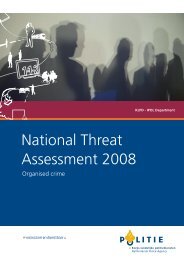Assessing the Effectiveness of Organized Crime Control Strategies ...
Assessing the Effectiveness of Organized Crime Control Strategies ...
Assessing the Effectiveness of Organized Crime Control Strategies ...
You also want an ePaper? Increase the reach of your titles
YUMPU automatically turns print PDFs into web optimized ePapers that Google loves.
many impediments to cooperation at <strong>the</strong> international level. Asset seizure and forfeiture also<br />
received a “low” rating, as just a fraction <strong>of</strong> crime proceeds are confiscated, <strong>the</strong> processes to<br />
achieve forfeiture, as well as <strong>the</strong> management <strong>of</strong> assets, are costly, and <strong>the</strong>re are concerns about<br />
abuses <strong>of</strong> due process. Finally, supply reduction strategies also received a “low” rating as <strong>the</strong>re<br />
are many indications globally that this approach, even when pursued aggressively, fails to<br />
appreciably affect <strong>the</strong> supply <strong>of</strong> illicit drugs, is very costly, and that traffickers have recourse to<br />
countless methods and routes <strong>of</strong> smuggling and distribution that circumvent interdiction and<br />
enforcement efforts.<br />
Undercover operations and <strong>the</strong> use <strong>of</strong> informants were collectively rated as “low to moderate” in<br />
terms <strong>of</strong> effectiveness. These operations have produced many convictions <strong>of</strong> high-echelon OC<br />
figures, have been critical in major proceeds <strong>of</strong> crime and money laundering cases, and at times<br />
have caused turmoil and demoralization within criminal organizations. However, <strong>the</strong>se<br />
advantages may be outweighed by some significant problems, such as <strong>the</strong>ir cost, danger and<br />
damage to <strong>the</strong> lives <strong>of</strong> <strong>of</strong>ficers, unreliability <strong>of</strong> and abuses by informers, concerns about<br />
entrapment, and potential for harm to third parties.<br />
Four OC control measures were rated as moderately effective—prosecutions <strong>of</strong> persons involved<br />
in OC, prosecutions through <strong>the</strong> use <strong>of</strong> taxation laws, OC strike forces and drug task forces, and<br />
electronic surveillance. With regard to <strong>the</strong> first, many individuals have been convicted for<br />
lengthy prison terms under <strong>the</strong> RICO legislation in <strong>the</strong> US and some crime families have been<br />
disabled as a result. This apparent success has been diminished by <strong>the</strong> frequent use <strong>of</strong> this<br />
legislation to prosecute those not involved in OC. Historically, taxation laws have been a<br />
valuable tool in <strong>the</strong> prosecution <strong>of</strong> OC figures; however, <strong>the</strong>ir utility is counterbalanced by <strong>the</strong><br />
cost <strong>of</strong> financial investigations and privacy concerns. OC strike forces and drug task forces<br />
launched coordinated attacks on OC in <strong>the</strong> US, involving many federal and local agencies. The<br />
drug task forces, in particular, have brought many indictments and asset forfeitures. On <strong>the</strong><br />
down side, <strong>the</strong> strike forces were eventually disbanded due to jurisdictional conflicts with US<br />
attorneys’ <strong>of</strong>fices. Electronic surveillance is considered by many investigators as indispensable<br />
in <strong>the</strong> investigation and prosecution <strong>of</strong> OC figures and has contributed to <strong>the</strong> conviction <strong>of</strong> some<br />
notorious individuals. These advantages are diminished by <strong>the</strong> costs <strong>of</strong> surveillance, privacy<br />
concerns, <strong>the</strong> mobility <strong>of</strong> OC members, and issues involved in <strong>the</strong> interpretation <strong>of</strong> material that<br />
has been intercepted.<br />
While no OC control measure was rated as “highly effective”, three were given an effectiveness<br />
rating <strong>of</strong> “moderate to high.” These three measures were: injunctions, divestitures, and<br />
trusteeships; witness protection programs; and, increasing regulation and establishing public<br />
benefit corporations.<br />
The first <strong>of</strong> <strong>the</strong>se is rarely discussed, perhaps because <strong>the</strong> measures fall outside <strong>the</strong> realm <strong>of</strong><br />
criminal law. Court orders to dissolve organizations or to remove those with OC connections<br />
from <strong>the</strong>ir influential positions have been found to be highly successful in some instances, where<br />
organizations have been seriously tainted. No shortcomings <strong>of</strong> <strong>the</strong>se remedies were mentioned<br />
in <strong>the</strong> limited literature on <strong>the</strong> topic. Never<strong>the</strong>less, a “high” rating was not accorded this<br />
approach as <strong>the</strong> evidence attesting to its utility was limited and somewhat partisan (i.e., much <strong>of</strong><br />
it was furnished by a former prosecutor who found <strong>the</strong>se tools useful). While such accounts may<br />
Research and Statistics Division / Department <strong>of</strong> Justice Canada | 59








